Session Map
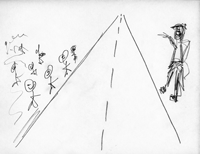 Session 1. Listen to youth – what do they bring to the dialog? Youth need to see you as the model; they want you to understand them but not be like them. Being a teacher means paying attention in particular kinds of ways.
Session 1. Listen to youth – what do they bring to the dialog? Youth need to see you as the model; they want you to understand them but not be like them. Being a teacher means paying attention in particular kinds of ways.
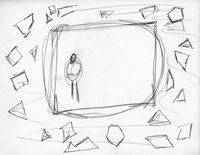 Session 2. With adolescents, invite them into a reflective process where they begin to look at their work differently and perhaps with a more critical eye. They begin to see their work as constructs of the human mind. We are not born knowing that a line means something.
Session 2. With adolescents, invite them into a reflective process where they begin to look at their work differently and perhaps with a more critical eye. They begin to see their work as constructs of the human mind. We are not born knowing that a line means something.
 Session 3. What do adolescents bring forward from childhood? Use of materials. Physical and cognitive contradictions. Disparity of growth; the parts are growing at different rates. A new relationship to space. Environment as mirror of self.
Session 3. What do adolescents bring forward from childhood? Use of materials. Physical and cognitive contradictions. Disparity of growth; the parts are growing at different rates. A new relationship to space. Environment as mirror of self.
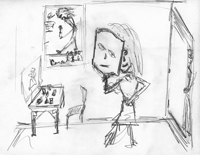 Session 4. ID confusion—multiple IDs. Adolescents are not sure who they are. They try on different identities. Who are you talking to today?
Session 4. ID confusion—multiple IDs. Adolescents are not sure who they are. They try on different identities. Who are you talking to today?
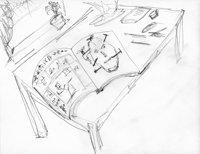 Session 5. Physical changes throw their center of gravity off balance. Adolescence is another sensory mode, a new period of learning, almost like a new toddlerhood. Adolescents over-estimate what they can do. Drawings and sketchbooks are safe places to play out these changes.
Session 5. Physical changes throw their center of gravity off balance. Adolescence is another sensory mode, a new period of learning, almost like a new toddlerhood. Adolescents over-estimate what they can do. Drawings and sketchbooks are safe places to play out these changes.
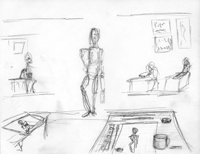 Session 6. Adolescent drawing shows an interest with the human figure. We put ourselves into the work in an experiential realism. The body is in space, present in space, and for the adolescent, present to themselves. Figure drawing is important for adolescent development.
Session 6. Adolescent drawing shows an interest with the human figure. We put ourselves into the work in an experiential realism. The body is in space, present in space, and for the adolescent, present to themselves. Figure drawing is important for adolescent development.
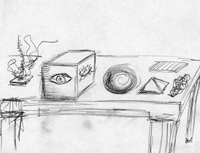 Session 7. The adolescent is developing a new sense of self. They have questions about what’s true and right, about what they need to do. Their art work is looked at critically—there's a requirement to make something look realistic, which is a shift from earlier ages.
Session 7. The adolescent is developing a new sense of self. They have questions about what’s true and right, about what they need to do. Their art work is looked at critically—there's a requirement to make something look realistic, which is a shift from earlier ages.
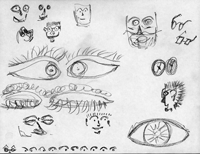 Session 8. Visiting high school students from Sheyda's class. Student portfolios and advice.
Session 8. Visiting high school students from Sheyda's class. Student portfolios and advice.
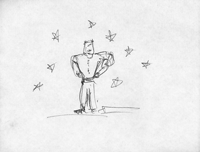 Session 9. How do young adults look back at the work they did as adolescents? Visiting teaching artists from TRUCE and the Harlem Children's Zone.
Session 9. How do young adults look back at the work they did as adolescents? Visiting teaching artists from TRUCE and the Harlem Children's Zone.
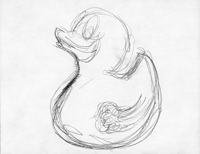 Session 10. From a normative sense, how does engagement in the arts nurture and affect young people? To be more attuned to art and culture; to be able to think critically; to be able to continue to make meaning. Also, Judy's first experiences of art education: drawing the duck.
Session 10. From a normative sense, how does engagement in the arts nurture and affect young people? To be more attuned to art and culture; to be able to think critically; to be able to continue to make meaning. Also, Judy's first experiences of art education: drawing the duck.
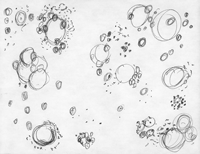 Session 11. Moving from high school to college years. The ziggy zaggy course from high school to the rest of your life.
Session 11. Moving from high school to college years. The ziggy zaggy course from high school to the rest of your life.
 Session 1. Listen to youth – what do they bring to the dialog? Youth need to see you as the model; they want you to understand them but not be like them. Being a teacher means paying attention in particular kinds of ways.
Session 1. Listen to youth – what do they bring to the dialog? Youth need to see you as the model; they want you to understand them but not be like them. Being a teacher means paying attention in particular kinds of ways.
 Session 2. With adolescents, invite them into a reflective process where they begin to look at their work differently and perhaps with a more critical eye. They begin to see their work as constructs of the human mind. We are not born knowing that a line means something.
Session 2. With adolescents, invite them into a reflective process where they begin to look at their work differently and perhaps with a more critical eye. They begin to see their work as constructs of the human mind. We are not born knowing that a line means something.
 Session 3. What do adolescents bring forward from childhood? Use of materials. Physical and cognitive contradictions. Disparity of growth; the parts are growing at different rates. A new relationship to space. Environment as mirror of self.
Session 3. What do adolescents bring forward from childhood? Use of materials. Physical and cognitive contradictions. Disparity of growth; the parts are growing at different rates. A new relationship to space. Environment as mirror of self.
 Session 4. ID confusion—multiple IDs. Adolescents are not sure who they are. They try on different identities. Who are you talking to today?
Session 4. ID confusion—multiple IDs. Adolescents are not sure who they are. They try on different identities. Who are you talking to today?
 Session 5. Physical changes throw their center of gravity off balance. Adolescence is another sensory mode, a new period of learning, almost like a new toddlerhood. Adolescents over-estimate what they can do. Drawings and sketchbooks are safe places to play out these changes.
Session 5. Physical changes throw their center of gravity off balance. Adolescence is another sensory mode, a new period of learning, almost like a new toddlerhood. Adolescents over-estimate what they can do. Drawings and sketchbooks are safe places to play out these changes.
 Session 6. Adolescent drawing shows an interest with the human figure. We put ourselves into the work in an experiential realism. The body is in space, present in space, and for the adolescent, present to themselves. Figure drawing is important for adolescent development.
Session 6. Adolescent drawing shows an interest with the human figure. We put ourselves into the work in an experiential realism. The body is in space, present in space, and for the adolescent, present to themselves. Figure drawing is important for adolescent development.
 Session 7. The adolescent is developing a new sense of self. They have questions about what’s true and right, about what they need to do. Their art work is looked at critically—there's a requirement to make something look realistic, which is a shift from earlier ages.
Session 7. The adolescent is developing a new sense of self. They have questions about what’s true and right, about what they need to do. Their art work is looked at critically—there's a requirement to make something look realistic, which is a shift from earlier ages.
 Session 8. Visiting high school students from Sheyda's class. Student portfolios and advice.
Session 8. Visiting high school students from Sheyda's class. Student portfolios and advice.
 Session 9. How do young adults look back at the work they did as adolescents? Visiting teaching artists from TRUCE and the Harlem Children's Zone.
Session 9. How do young adults look back at the work they did as adolescents? Visiting teaching artists from TRUCE and the Harlem Children's Zone.
 Session 10. From a normative sense, how does engagement in the arts nurture and affect young people? To be more attuned to art and culture; to be able to think critically; to be able to continue to make meaning. Also, Judy's first experiences of art education: drawing the duck.
Session 10. From a normative sense, how does engagement in the arts nurture and affect young people? To be more attuned to art and culture; to be able to think critically; to be able to continue to make meaning. Also, Judy's first experiences of art education: drawing the duck.
 Session 11. Moving from high school to college years. The ziggy zaggy course from high school to the rest of your life.
Session 11. Moving from high school to college years. The ziggy zaggy course from high school to the rest of your life.